第十三章 运算符重载
- 格式:ppt
- 大小:144.00 KB
- 文档页数:35
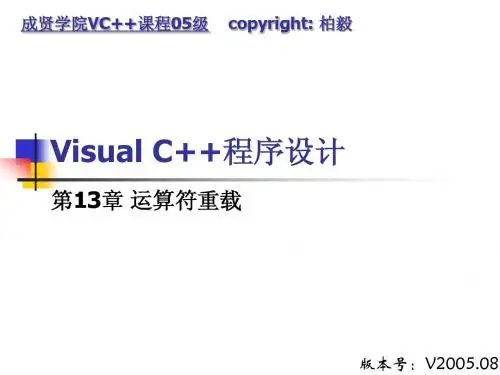
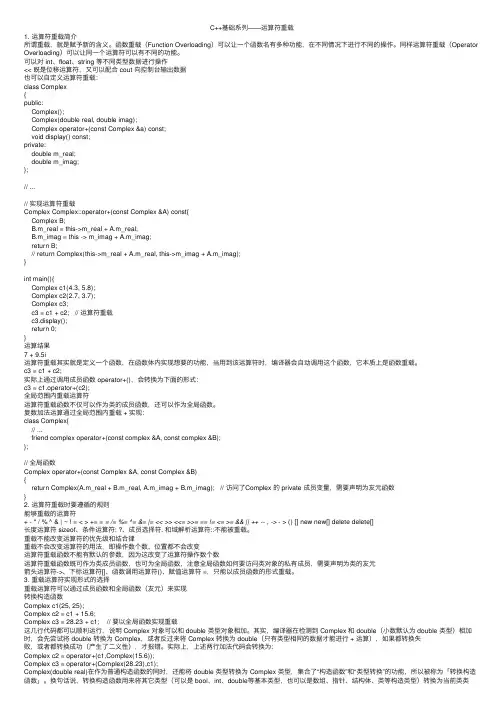
C++基础系列——运算符重载1. 运算符重载简介所谓重载,就是赋予新的含义。
函数重载(Function Overloading)可以让⼀个函数名有多种功能,在不同情况下进⾏不同的操作。
同样运算符重载(Operator Overloading)可以让同⼀个运算符可以有不同的功能。
可以对 int、float、string 等不同类型数据进⾏操作<< 既是位移运算符,⼜可以配合 cout 向控制台输出数据也可以⾃定义运算符重载:class Complex{public:Complex();Complex(double real, double imag);Complex operator+(const Complex &a) const;void display() const;private:double m_real;double m_imag;};// ...// 实现运算符重载Complex Complex::operator+(const Complex &A) const{Complex B;B.m_real = this->m_real + A.m_real;B.m_imag = this -> m_imag + A.m_imag;return B;// return Complex(this->m_real + A.m_real, this->m_imag + A.m_imag);}int main(){Complex c1(4.3, 5.8);Complex c2(2.7, 3.7);Complex c3;c3 = c1 + c2; // 运算符重载c3.display();return 0;}运算结果7 + 9.5i运算符重载其实就是定义⼀个函数,在函数体内实现想要的功能,当⽤到该运算符时,编译器会⾃动调⽤这个函数,它本质上是函数重载。
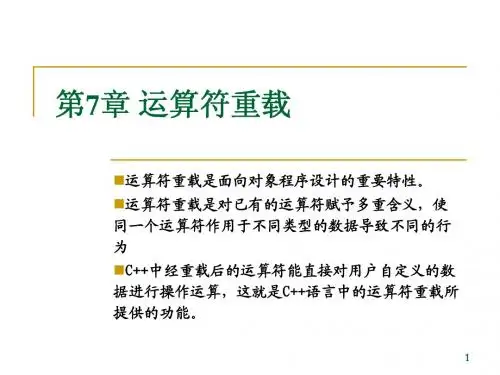
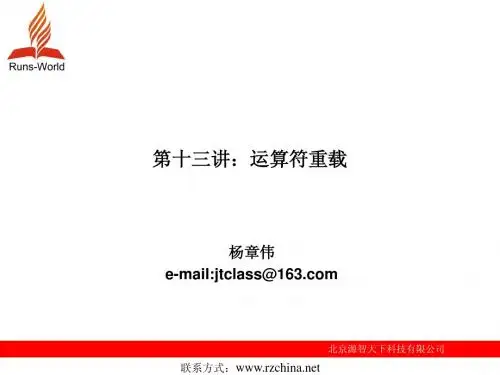
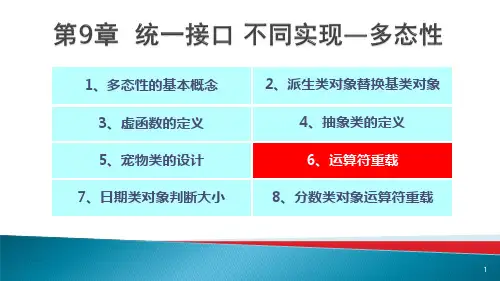
1、多态性的基本概念2、派生类对象替换基类对象3、虚函数的定义4、抽象类的定义5、宠物类的设计6、运算符重载7、日期类对象判断大小8、分数类对象运算符重载☐运算符重载指赋予运算符新的操作功能,主要用于对类的对象的操作☐运算符+意味着多少对象类型的加法呢?☐还可以定义新的对象类型加法☐运算符重载定义形式:<类型><类名>::operator<操作符>(<参数表>){函数体}☐首先定义虚数类☐虚数可以描述为:a+bi☐a与b看成实数,定义成double类型☐成员函数除了构造与析构外,还有:☐输出虚数、修改虚数、得到实部a、得到虚部b ☐相加+、判相等==#include <iostream>using namespace std;class Complex{private:double real, imag;public:Complex(double r = 0, double i = 0): real(r), imag(i){ }double Real(){return real;}double Imag(){return imag;}Complex operator +(Complex&);Complex operator +(double);bool operator ==(Complex);~Complex(){ };Complex Complex::operator +(Complex &c)// 重载运算符+,两边是虚数对象{Complex temp;temp.real = real+c.real;temp.imag = imag+c.imag;return temp;}Complex Complex::operator +(double d)// 重载运算符+,左边是虚数对象,右边是双精度数{Complex temp;temp.real = real+d;temp.imag=imag;return temp;}bool Complex::operator ==(Complex c)// 重载运算符=={if (real == c.real && imag == c.imag)return true;elseint main(){Complex c1(3,4),c2(5,6),c3;cout << "C1 = " << c1.Real() << "+j" << c1.Imag() << endl;cout << "C2 = " << c2.Real() << "+j" << c2.Imag() << endl;c3 = c1+c2;cout << "C3 = " << c3.Real() << "+j" << c3.Imag() << endl;c3 = c3+6.5;cout << "C3 + 6.5 = " << c3.Real() << "+j" << c3.Imag() << endl;if ( c1==c2 )cout<<“两个复数相等”;elsecout<<“两个复数不相等”;return 0;☐运算符++分前置运算符和后置运算符☐例如: ++Y与Y++☐前置运算符定义Complex Complex::operator ++ () {real+=1;return *this;}☐后置运算符定义Complex Complex::operator ++ (int) {real+=1;return *this;}。
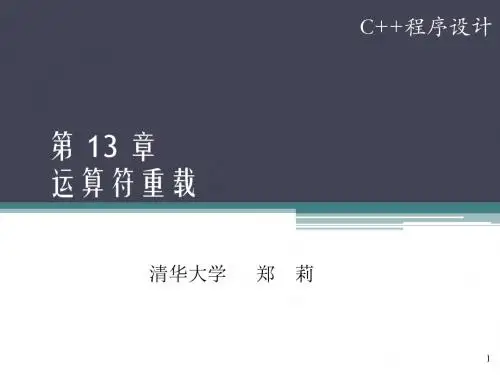
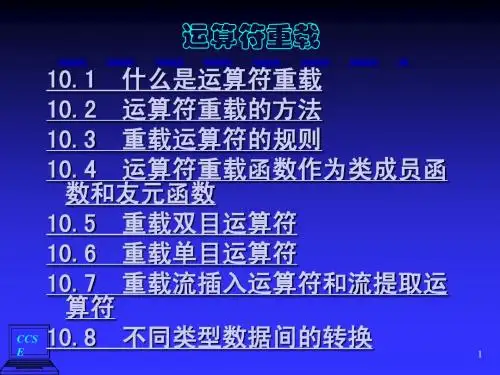
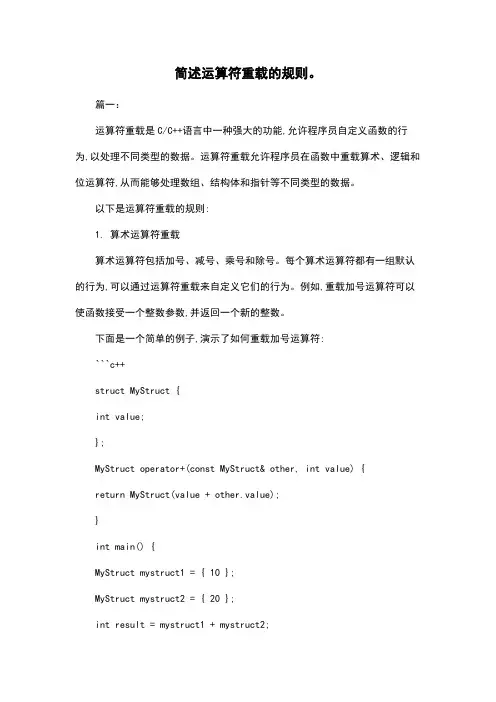
简述运算符重载的规则。
篇一:运算符重载是C/C++语言中一种强大的功能,允许程序员自定义函数的行为,以处理不同类型的数据。
运算符重载允许程序员在函数中重载算术、逻辑和位运算符,从而能够处理数组、结构体和指针等不同类型的数据。
以下是运算符重载的规则:1. 算术运算符重载算术运算符包括加号、减号、乘号和除号。
每个算术运算符都有一组默认的行为,可以通过运算符重载来自定义它们的行为。
例如,重载加号运算符可以使函数接受一个整数参数,并返回一个新的整数。
下面是一个简单的例子,演示了如何重载加号运算符:```c++struct MyStruct {int value;};MyStruct operator+(const MyStruct& other, int value) {return MyStruct(value + other.value);}int main() {MyStruct mystruct1 = { 10 };MyStruct mystruct2 = { 20 };int result = mystruct1 + mystruct2;std::cout << "result = " << result << std::endl;return 0;}```在上面的例子中,我们定义了一个名为`MyStruct`的结构体类型,其中包含一个整数类型。
然后,我们定义了一个重载加号运算符的函数,该函数接受一个整数类型的参数,并返回一个新的`MyStruct`对象。
在`main`函数中,我们定义了两个`MyStruct`对象`mystruct1`和`mystruct2`,并将它们相加,结果存储在`result`变量中。
2. 逻辑运算符重载逻辑运算符包括条件运算符和逻辑非运算符。
每个逻辑运算符都有一组默认的行为,可以通过运算符重载来自定义它们的行为。
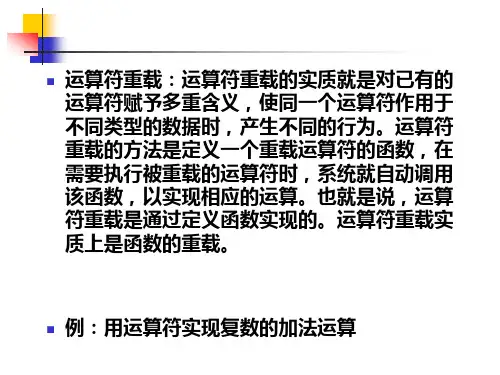
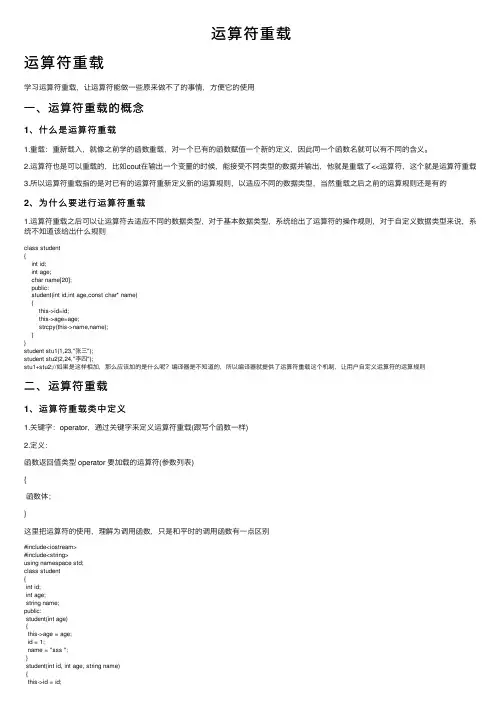
运算符重载运算符重载学习运算符重载,让运算符能做⼀些原来做不了的事情,⽅便它的使⽤⼀、运算符重载的概念1、什么是运算符重载1.重载:重新载⼊,就像之前学的函数重载,对⼀个已有的函数赋值⼀个新的定义,因此同⼀个函数名就可以有不同的含义。
2.运算符也是可以重载的,⽐如cout在输出⼀个变量的时候,能接受不同类型的数据并输出,他就是重载了<<运算符,这个就是运算符重载3.所以运算符重载指的是对已有的运算符重新定义新的运算规则,以适应不同的数据类型,当然重载之后之前的运算规则还是有的2、为什么要进⾏运算符重载1.运算符重载之后可以让运算符去适应不同的数据类型,对于基本数据类型,系统给出了运算符的操作规则,对于⾃定义数据类型来说,系统不知道该给出什么规则class student{int id;int age;char name[20];public:student(int id,int age,const char* name){this->id=id;this->age=age;strcpy(this->name,name);}}student stu1(1,23,"张三");student stu2(2,24,"李四");stu1+stu2;//如果是这样相加,那么应该加的是什么呢?编译器是不知道的,所以编译器就提供了运算符重载这个机制,让⽤户⾃定义运算符的运算规则⼆、运算符重载1、运算符重载类中定义1.关键字:operator,通过关键字来定义运算符重载(跟写个函数⼀样)2.定义:函数返回值类型 operator 要加载的运算符(参数列表){函数体;}这⾥把运算符的使⽤,理解为调⽤函数,只是和平时的调⽤函数有⼀点区别#include<iostream>#include<string>using namespace std;class student{int id;int age;string name;public:student(int age){this->age = age;id = 1;name = "sss ";}student(int id, int age, string name){this->id = id;this->age = age;this->name = name;}void showstudent(){cout << id << "\t" << age << "\t" << name << endl;}student operator+(student& p1)//这个函数会返回⼀个新的对象{int x=this->age + p1.age;student p(x);return p;//返回的是⼀个对象,会调⽤拷贝构造}int operator-(int x){return this->id - x;}void operator+(student&p2){cout << this->id + p2.id << endl;}};//1.操作这个运算符之后,返回值类型是什么int main(){student p1(0, 1, "yunfei");int x = p1.operator-(1);cout << x << endl;student stu1(1, 23, "张三");student stu2(2, 24, "李四");//student stu3 = stu1.operator+(stu2);//student stu3 = stu1 + stu2;stu1 + stu2;//stu3.showstudent();system("pause");return 0;}注意:因为我们这个运算符是在类中写的,所以是通过对象调⽤的,那么this指针会占⼀个参数,⽽且是第⼀个参数,也就是说我们重载⼀个运算符,是在类中,⽽这个运算符是个单⽬运算符,那么参数列表就不⽤写东西了,是双⽬运算符,那么就需要传另⼀个参数进来绝⼤部分的运算符重载都可以参照上⾯这个+号重载2、运算符重载的特点1.⼏乎所有的运算符都可以被重载,除了 . :: ()?() ) sizeof()2.运算符重载基本出现在类中和结构体中3.运算符可以理解为函数的⼀个表现3、运算符重载的注意事项1.重载运算符,这个重载的运算符还是满⾜原来的原则,但不能说重载+号,结果做的事-号的事,这样会使运算符的运⽤上增加很⼤的难度2.运算符重载的参数,类中重载调⽤对象会占⼀个参数,就是this会占⼀个参数,参数列表就是⽤来表⽰运算符的操作的3.对于运算符重载的调⽤,可以直接使⽤运算符,也可以通过对象 . 出来调⽤4.考虑返回值,不同的运算符有不同的返回值,要记得满⾜运算符原来的规则4、使⽤友元函数,实现运算符重载1.类在已经实现且部分修改的情况下下,需要进⾏运算符重载,就可以通过友元的⽅式来进⾏重载#include<iostream>#include<string>using namespace std;class person{int id;int age;string name;public:person(int id, int age, string name){this->id = id;this->age = age;this->name = name;}void showperson(){cout << id << "\t" << age << "\t" << name << endl;}friend int operator+(person&p1, person&p2);};//形参使⽤的是类对象的引⽤,在实参传对象的时候不会调⽤拷贝构造int operator+(person&p1, person&p2){return p1.id + p2.id;}//1.操作这个运算符之后,返回值类型是什么int main(){person stu1(1, 23, "张三");person stu2(2, 24, "李四");int x = operator+(stu1, stu2);//显⽰调⽤int y = stu1 + stu2;//隐式调⽤cout << x << endl << y << endl;system("pause");return 0;}容器:#include<iostream>#include<vector>using namespace std;int main(){//int 是v1这个容器存的类型vector<int> v1;for (int i = 0; i < 10; i++){//push_back()是⼀个函数,功能是尾插元素v1.push_back(i + 1);}for (int i = 0; i < 10; i++){cout << v1[i] << "\t";}system("pause");return 0;}左移右移运算符重载:#include<iostream>using namespace std;class person{int id;public:person(int id){this->id = id;}friend ostream& operator<<(ostream& os, person& p1);friend istream & operator>>(istream & in, person & p2);};//左移右移运算符重载,必须在类外重载,通过友元实现ostream& operator<<(ostream& os, person& p1)//左移运算符{os << p1.id << endl;return os;//返回的是⼀个cout,⽽且只能⽤引⽤}istream & operator>>(istream & in, person & p2)//右移运算符{in >> p2.id;return in;}int main(){person p1(10), p2(20);cin >> p1 >> p2;cout << p1 << endl << p2 << endl;system("pause");return 0;}前++,后++运算符重载:#include<iostream>using namespace std;class person{int id;public:person(int id){this->id = id;}person& operator++()//前++{this->id++;return *this;}person& operator++(int)//后++,int是⼀个占位符,⽤来区分前++和后++的{static person temp = *this;//引⽤不能返回局部变量,要⽤静态变量this->id++;return temp;}friend ostream& operator<<(ostream& os, person& p1);friend istream & operator>>(istream & in, person & p2);};//左移右移运算符重载,必须在类外重载,通过友元实现ostream& operator<<(ostream& os, person& p1)//左移运算符{os << p1.id << endl;return os;//返回的是⼀个cout,⽽且只能⽤引⽤}istream & operator>>(istream & in, person & p2)//右移运算符{in >> p2.id;return in;}int main(){person p1(10), p2(20);//cin >> p1 >> p2;//cout << p1 << endl << p2 << endl;cout << p1 ;//10cout << p1++ ;//10cout << p1 ;//11cout << ++p1 ;//12cout << p1 ;//12system("pause");return 0;}等号运算符重载:#include<iostream>using namespace std;class person{char* name;public:person(const char* name){this->name = new char[strlen(name) + 1];strcpy(this->name, name);}person& operator=(person&p1)//⽤不⽤引⽤传参,要看返回的对象会不会消失 {if (this->name != NULL){delete[]this->name;this->name = NULL;}this->name = new char[strlen() + 1];strcpy(this->name, );return *this;}void show(){cout << name << endl;}~person()//如果有申请函数,就要加上析构函数{if (name != NULL){delete[]name;name = NULL;}}};int main(){{person p1("张三"), p2("李四"), p3("王五");p1 = p2 = p3;p1.show();p2.show();p3.show();}//加上⼤括号,让对象死亡,就能调⽤析构函数system("pause");return 0;}智能指针和==号运算符重载:#include<iostream>using namespace std;class person{int id;public:person(int id){this->id = id;}void show(){cout << id << endl;}bool operator==(person& p){return this->id == p.id;}~person(){cout << "person的析构函数" << endl;}};class smartpointer{person* ps;//包含你要new出来的对象的类的指针public:smartpointer(person* p){ps = p;}//重载->person* operator->()//传回来的是地址,不是对象,不⽤引⽤{return ps;}//重载*person& operator*()//返回的是对象,会调⽤拷贝构造,所以⽤返回值⽤引⽤,就不会再调⽤拷贝构造了 {return *ps;//得到⼀个对象,}~smartpointer(){if (ps != NULL){delete ps;ps = NULL;}}};int main(){{smartpointer p(new person(5));p->show();(*p).show();person p1(1), p2(3);cout << (p1 == p2) << endl;}//有三个对象,所以析构函数执⾏了三次system("pause");return 0;}[]运算符重载:#include<iostream>using namespace std;class person{char* name;public:person(const char* name){this->name = new char[strlen(name) + 1];strcpy(this->name, name);}char& operator[](int index){return name[index];}~person(){if (name != NULL){delete[]name;name = NULL;}cout << "这是析构函数" << endl;}};int main(){person p("asdfg");cout << p[3] << endl;system("pause");return 0;}c++引⽤作为函数返回值:1.以引⽤返回函数值,定义函数时需要在函数名前加 &2.⽤引⽤返回⼀个函数值的最⼤好处是,在内存中不产⽣被返回值的副本3.返回值为引⽤的时候,返回的是⼀个地址,隐形指针4.当返回值不是引⽤时,编译器会专门给返回值分配出⼀块内存的引⽤作为返回值,必须遵守以下规则:(1)不能返回局部变量的引⽤。
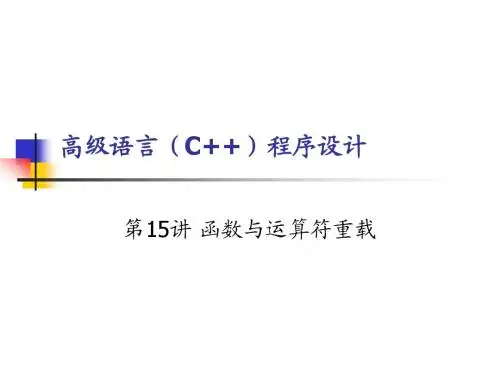
C++运算符重载(简单易懂)运算符重载,就是对已有的运算符重新进⾏定义,赋予其另⼀种功能,以适应不同的数据类型。
你可以重定义或重载⼤部分 C++ 内置的运算符。
例如 + 、 - 、 * 、 / 、++、--、>>、<<等,这样,你就能使⽤⾃定义类型的运算符。
运算符重载的基本格式重载的运算符是带有特殊名称的函数,函数名是由关键字 operator 和其后要重载的运算符符号构成的。
与其他函数⼀样,重载运算符有⼀个返回类型和⼀个参数列表。
Point operator+(const Point &);运算符重载有两种⽅式:⼀种是类内重载(运算符重载函数作为类的成员函数),另⼀种是类外重载(运算符重载函数作为类的友元函数)类内重载#include <iostream>using namespace std;class Point{public:Point(){};Point (int x, int y): x(x),y(y) {};Point operator+(const Point &a){ //类内重载,运算符重载函数作为类的成员函数Point ret;ret.x = this->x + a.x;ret.y = this->y + a.y;return ret;}int x,y;};int main() {Point a(2,4),b(5,3);Point c = a + b;cout<< "x :" << c.x << endl;cout<<"y :" << c.y << endl;}当上⾯的代码被编译和执⾏时,它会产⽣下列结果:x : 7y: 7运算符重载是类内重载时,运算符重载函数作为类的成员函数,以上述代码为例 a + b 相当于 a 对象调⽤+⽅法并且传⼊参数时 b 对象类外重载#include <iostream>using namespace std;class Point{public:Point(){};Point (int x, int y): x(x),y(y) {};friend Point operator+(const Point &, const Point &);int x,y;};Point operator+(const Point &a,const Point &b){//类外重载,运算符重载函数作为类的友元函数Point ret;ret.x = a.x + b.x;ret.y = a.y + b.y;return ret;}int main() {Point a(2,4),b(5,3);cout<< "x :" << c.x << endl;cout<<"y :" << c.y << endl;}当上⾯的代码被编译和执⾏时,它会产⽣和上⾯⼀样的结果各种运算符重载实例下⾯将进⾏各种运算符重载实例的代码演⽰,演⽰⼏种基本的运算符重载。
运算符重载什么是运算符的重载?运算符与类结合,产⽣新的含义。
为什么要引⼊运算符重载?作⽤:为了实现类的多态性(多态是指⼀个函数名有多种含义)怎么实现运算符的重载?⽅式:类的成员函数或友元函数(类外的普通函数)规则:不能重载的运算符有 . 和 .* 和 ?: 和 :: 和 sizeof友元函数和成员函数的使⽤场合:⼀般情况下,建议⼀元运算符使⽤成员函数,⼆元运算符使⽤友元函数1、运算符的操作需要修改类对象的状态,则使⽤成员函数。
如需要做左值操作数的运算符(如=,+=,++)2、运算时,有数和对象的混合运算时,必须使⽤友元3、⼆元运算符中,第⼀个操作数为⾮对象时,必须使⽤友元函数。
如输⼊输出运算符<<和>>具体规则如下:运算符建议使⽤所有⼀元运算符成员函数= ( ) [ ] ->必须是成员函数+= -= /= *= ^= &= != %= >>= <<= , 似乎带等号的都在这⾥了成员函数所有其它⼆元运算符, 例如: –,+,*,/友元函数<< >>必须是友元函数2. 参数和返回值当参数不会被改变,⼀般按const引⽤来传递(若是使⽤成员函数重载,函数也为const).对于返回数值的决定:1) 如果返回值可能出现在=号左边, 则只能作为左值, 返回⾮const引⽤。
2) 如果返回值只能出现在=号右边, 则只需作为右值, 返回const型引⽤或者const型值。
3) 如果返回值既可能出现在=号左边或者右边, 则其返回值须作为左值, 返回⾮const引⽤。
运算符重载举例:+和 -运算符的重载:class Point{private:int x;public:Point(int x1){ x=x1;}Point(Point& p){ x=p.x;}const Point operator+(const Point& p);//使⽤成员函数重载加号运算符friend const Point operator-(const Point& p1,const Point& p2);//使⽤友元函数重载减号运算符};const Point Point::operator+(const Point& p){return Point(x+p.x);}Point const operator-(const Point& p1,const Point& p2){return Point(p1.x-p2.x);}输出:Point a(1);Point b(2);a+b; //正确,调⽤成员函数a-b; //正确,调⽤友元函数a+1; //正确,先调⽤类型转换函数,把1变成对象,之后调⽤成员函数a-1; //正确,先调⽤类型转换函数,把1变成对象,之后调⽤友元函数1+a; //错误,调⽤成员函数时,第⼀个操作数必须是对象,因为第⼀个操作数还有调⽤成员函数的功能1-a; //正确,先类型转换后调⽤友元函数总结:1、由于+ -都是出现在=号的右边,如c=a+b,即会返回⼀个右值,可以返回const型值2、后⼏个表达式讨论的就是,数和对象混合运算符的情况,⼀般出现这种情况,常使⽤友元函数3、双⽬运算符的重载:重载运算符函数名:operator@(参数表)隐式调⽤形式:obj1+obj2显式调⽤形式:obj1.operator+(OBJ obj2)---成员函数operator+(OBJ obj1,OBJ obj2)---友元函数执⾏时,隐式调⽤形式和显式调⽤形式都会调⽤函数operator+()++和--运算符的class Point{private:int x;public:Point(int x1){ x=x1;}Point operator++();//成员函数定义⾃增const Point operator++(int x); //后缀可以返回⼀个const类型的值friend Point operator--(Point& p);//友元函数定义--friend const Point operator--(Point& p,int x);//后缀可以返回⼀个const类型的值};Point Point::operator++()//++obj{x++;return *this;}const Point Point::operator++(int x)//obj++{Point temp = *this;this->x++;return temp; // 需要返回⼀个临时对象,效率不如 ++obj ⾼}Point operator--(Point& p)//--obj{p.x--;return p;//前缀形式(--obj)重载的时候没有虚参,通过引⽤返回*this 或⾃⾝引⽤,也就是返回变化之后的数值}const Point operator--(Point& p,int x)//obj--{Point temp = p;p.x--;return temp;// 后缀形式obj--重载的时候有⼀个int类型的虚参, 返回原状态的拷贝}调⽤:Point b(2);a++;//隐式调⽤成员函数operator++(0),后缀表达式++a;//隐式调⽤成员函数operator++(),前缀表达式b--;//隐式调⽤友元函数operator--(0),后缀表达式--b;//隐式调⽤友元函数operator--(),前缀表达式cout<<a.operator ++(2);//显式调⽤成员函数operator ++(2),后缀表达式cout<<a.operator ++();//显式调⽤成员函数operator ++(),前缀表达式cout<<operator --(b,2);//显式调⽤友元函数operator --(2),后缀表达式cout<<operator --(b);//显式调⽤友元函数operator --(),前缀表达式 </pre>总结:1、a++函数返回:temp(临时变量)函数返回是否是const类型:返回是⼀个拷贝后的临时变量),不能出现在等号的左边(临时变量不能做左值),函数的结果只能做右值,则要返回⼀个const类型的值++a函数返回:*this;函数返回是否是const类型:返回原状态的本⾝,返回值可以做左值,即函数的结果可以做左值,则要返回⼀个⾮const类型的值2、前后缀仅从函数名(operator++)⽆法区分,只能有参数区分,这⾥引⼊⼀个虚参数int x,x可以是任意整数。
C++学习之运算符重载的总结C++学习之运算符重载的总结运算符重载是对已有的运算符赋予多重含义,使同⼀个运算符作⽤域不同类型的数据导致不同⾏为的发⽣,C++为运算符重载提供了⼀种⽅法,即运算符重载函数。
其函数名字规定为operator后紧跟重载运算符。
⽐如:operator+(),operator*()等。
(1)运算符重载函数作为类的友元函数的形式: class 类名 { friend 返回类型 operator运算符(形参表); } 类外定义格式: 返回类型 operator运算符(参数表) { 函数体 }友元函数重载双⽬运算符(有两个操作数,通常在运算符的左右两则),参数表中的个数为两个。
若是重载单⽬运算符(只有⼀个操作数),则参数表中只有⼀参数。
同⼀个运算符可以定义多个运算符重载函数来进⾏不同的操作。
(2)运算符重载函数作为类的成员函数的形式: class 类名 { 返回类型 operator 运算符(形参表); } 类外定义格式: 返回类型类名:: operator 运算符(形参表) { 函数体; }对于成员函数重载运算符⽽⾔,双⽬运算符的参数表中仅有⼀个参数,⽽单⽬则⽆参数。
同样的是重载,为什么和友元函数在参数的个数上会有所区别的。
原因在于友元函数,没有this指针。
对于双⽬运算符⽽⾔,运算符重载函数的形参中仅为⼀个参数,它作为运算符的右操作数(如com2对象),⽽当前对象作为左操作数(如:上述中的com1对象),它是通过this指针隐含传递给成员运算符重载函数的。
例如下⾯这样的定义:Complex operator+(Complex com1);//成员函数重载双⽬运算符+20Complex Complex::operator+(Complexcom1)21{22return Complex(real+com1.real,imag+com1.imag);23}对于单⽬运算符⽽⾔,当前对象作为运算符的操作数。
运算符重载详解1.运算符重载定义:C++中预定义的运算符的操作对象只能是基本数据类型。
但实际上,对于许多⽤户⾃定义类型(例如类),也需要类似的运算操作。
这时就必须在C++中重新定义这些运算符,赋予已有运算符新的功能,使它能够⽤于特定类型执⾏特定的操作。
运算符重载的实质是函数重载,它提供了C++的可扩展性,也是C++最吸引⼈的特性之⼀。
运算符重载是通过创建运算符函数实现的,运算符函数定义了重载的运算符将要进⾏的操作。
运算符函数的定义与其他函数的定义类似,惟⼀的区别是运算符函数的函数名是由关键字operator和其后要重载的运算符符号构成的。
运算符函数定义的⼀般格式如下:<返回类型说明符> operator <运算符符号>(<参数表>){<函数体>} 2.运算符重载时要遵循以下规则:(1) 除了类属关系运算符"."、成员指针运算符".*"、作⽤域运算符"::"、sizeof运算符和三⽬运算符"?:"以外,C++中的所有运算符都可以重载。
(2) 重载运算符限制在C++语⾔中已有的运算符范围内的允许重载的运算符之中,不能创建新的运算符。
(3) 运算符重载实质上是函数重载,因此编译程序对运算符重载的选择,遵循函数重载的选择原则。
(4) 重载之后的运算符不能改变运算符的优先级和结合性,也不能改变运算符操作数的个数及语法结构。
(5) 运算符重载不能改变该运算符⽤于内部类型对象的含义。
它只能和⽤户⾃定义类型的对象⼀起使⽤,或者⽤于⽤户⾃定义类型的对象和内部类型的对象混合使⽤时。
(6) 运算符重载是针对新类型数据的实际需要对原有运算符进⾏的适当的改造,重载的功能应当与原有功能相类似,避免没有⽬的地使⽤重载运算符。
(7)重载运算符的函数不能有默认的参数,否则就改变了运算符的参数个数,与前⾯第3点相⽭盾了;(8)重载的运算符只能是⽤户⾃定义类型,否则就不是重载⽽是改变了现有的C++标准数据类型的运算符的规则了,会引会天下⼤乱的;(9)⽤户⾃定义类的运算符⼀般都必须重载后⽅可使⽤,但两个例外,运算符“=”和“&”不必⽤户重载;(10)运算符重载可以通过成员函数的形式,也可是通过友元函数,⾮成员⾮友元的普通函数。